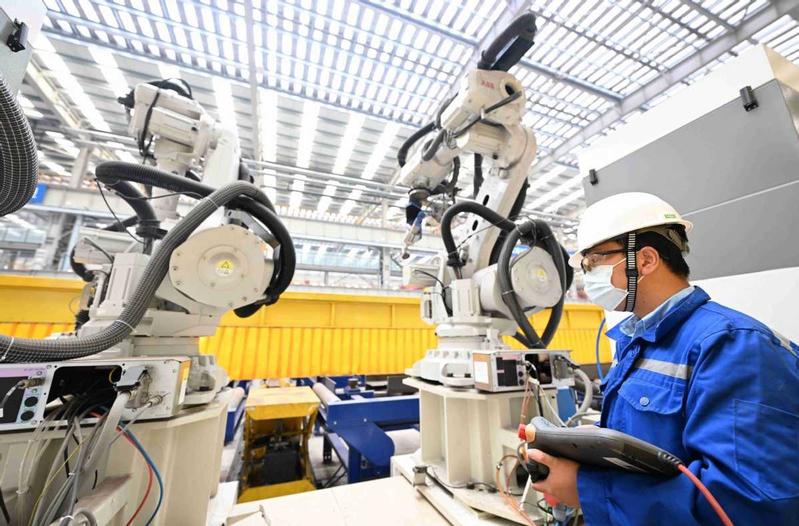 An employee works at a smart production facility in Tianjin in June. (PHOTO / XINHUA)
An employee works at a smart production facility in Tianjin in June. (PHOTO / XINHUA)
According to the General Administration of Customs, China's imports and exports hit a record high of 42.07 trillion yuan ($6.62 trillion) last year, ranking top in the world for six consecutive years.
Many local governments have chartered flights for local entrepreneurs and business leaders to travel abroad to compete for overseas markets. Among the latest business groups to travel abroad to seek orders are a delegation from Guizhou province, one of China's poorest provinces, to Russia to take part in a trade expo, and 15 bicycle enterprises led by Xingtai Tianfu Bicycle Co from Pingxiang county of Hebei province to Indonesia.
Since the world’s demand for manufacturing goods remains constant, part of China’s manu-facturing industries might shift to countries such as Vietnam and India due to their competitive-ness, which is both a challenge and an opportunity for China
But given the increasing pace of industrial restructuring in the post-COVID period, China will face a series of challenges at home and abroad which can be dealt with only by working together with other countries.
First, China faces the challenge of the restructuring of global industrial chains. From the launch of reform and opening-up in 1978 to the global financial crisis in 2008, China took advantage of the low cost of labor to gradually climb up the global chains, with labor-intensive processing products comprising a high percentage of the country's foreign trade. But since 2008, the proportion of processing products is down from a half to a quarter of the foreign trade.
Thanks to its economic rise and the Chinese people's growing incomes — which means higher labor costs — China is less competitive than Vietnam and India in the labor-intensive sectors. Apart from that, to maintain its hegemony, the United States is ramping up efforts to target China's high-tech industry. And not surprisingly, some other countries have been caught in the middle of the Sino-US trade disputes.
Given the adverse factors, China has to preserve the existing industries to maintain a healthy level of employment and growth, and intensify efforts to climb up to the upper end of the global industry chains to achieve high-quality development.
Transforming the economy is a challenge that China has to face as a major power at this stage. And higher-quality opening-up and reform are the best way of doing so.
Second, the COVID-19 pandemic has interrupted the global industry chains and hindered China's participation in global economic activities. Yet the shock is likely to be short term, as other countries have also been affected — and China's industrial chains, contrary to some claims, will not shift overseas.
Also, as the Chinese economy grows, the share of "made in China" products and services in the global economy may decline, especially because the country is marching toward an era of "created in China". Since the world's demand for manufacturing goods remains constant, part of China's manufacturing industries might shift to countries such as Vietnam and India due to their competitiveness, which is both a challenge and an opportunity for China.
Third, the pandemic of the past three years forced millions of businesses to communicate and do business online, which may be good but not as good as face-to-face communication for business.
That's why in the post-pandemic period, Chinese companies will make even more efforts to boost their and the country's economic ties with the world. The report to the 20th National Congress of the Communist Party of China points out that China adheres to the basic policy of reform and opening-up, pursues a mutually beneficial and win-win opening-up strategy, strives to create new opportunities for the world with its own development, contributes its share to build an open world economy and improve the lives and livelihoods of people of all countries.
The report also says China will remain an integral part of the international division of labor and global cooperation, and endeavor to preserve the diversity and stability of the global economic landscape. Under the guidance of these national policies, Chinese enterprises will explore the overseas markets: to stabilize and optimize exports; expand imports; introduce foreign capital; and invest abroad.
There's no more time to wait. Despite the rise of anti-globalization sentiments in some parts of the world, economic globalization is here to stay, and China will continue to work with the world to boost economic and trade exchanges in the post-pandemic era.
To deal with all these challenges, countries around the world should deepen cooperation, and take advantage of the digital economy and the ebbing pandemic to strengthen the global supply, industry and value chains so as to ensure orderly and healthy global growth.
The author is a researcher at the Institute of World Economics and Politics, Chinese Academy of Social Sciences.
The views don't necessarily represent those of China Daily.


